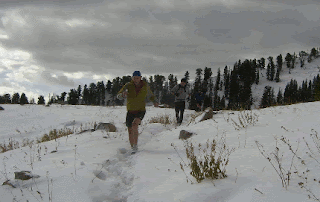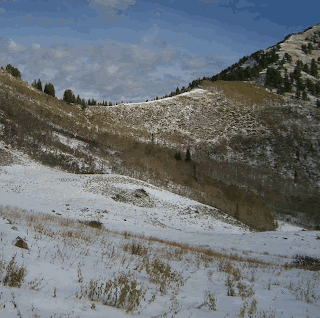Apparently the flowmeter will do a bit more than tell you how much fluid you've consumed. The display shown above reports how much has been consumed out of the total available. The amount added to the reservoir needs be entered by the user. I can't tell for sure bit it looks like that amount will be retained in memory so it won't be necessary to enter 70 oz. every time you fill you 70 oz. reservoir.
Using an advanced mode the user can input their weight and the flowmeter will calculate a PHG or Personal Hydration Goal. The PHG can also be entered manually if you already know how much you need to drink per hour and can be adjusted on the fly. Maybe you start in cool temps in the morning and make an adjustment as the temperature rises. In line with this feature the flowmeter will also indicate how many ounces you still have to drink before reaching your goal.
Another interesting feature is the Estimated Time to Empty. This figure is calculated based on rate of fluid that has been consumed over time. A side benefit that comes with this feature is a timer that counts up from the last time it was reset. Not exactly necessary since most people have their own timekeeping devices already but it another thing they can add to the list of features. One thing that doesn't make sense to me is that the timer will reset once it reaches 24 hours. It's not a limitation on the display so I don't understand why it couldn't continue to count upwards to 99 hours. When your reservoir falls below 10% of the total volume the display will flash "LO" to let you know you will soon turn into a shriveled pile of bones.
The user also has the option to select between english or metric units and the display relies on a set of abbreviations that you'll have to get familiar with listed below:
- AC: Amount Consumed
- ET: Elapsed Time
- PHG: Personal Hydration Goal
- AG: Amount to Goal
- AR/TV: Amount Remaining/Total Volume
- ETE: Estimated Time to Empty
The battery that it uses is a CR2032 watch battery (coincidentally the same I use in Petzl E+Lite). The device that is used to measure the flow is an impeller and looks quite susceptible to getting stuck. Camelbak seem to have addressed this by allowing access to it so that it can be cleaned.
That's nice but I doubt I'm going to stop mid-run or ride and clean it out just so I can get accurate measurements. The other downside with the impeller is that a considerable amount of pressure needs to be applied to get them to spin. This means if you don't suck hard enough on the bite valve the meter won't record. Freezing temps are also going to present some problems but that's already an issue with keeping the tube flowing in cold conditions. The weight of the unit is still a mystery but not the way it attaches. It looks as though it uses two plastic rails that slide on straps used on Camelbaks. So if you're going to use this with a different pack you'll have to figure out a way to keep it mounted where you want it.
At $30, I think I'm going to hold off getting one anytime real soon. I want to see some initial reports before I take the plunge. If you've tried it I would really like to hear about your experience with it, please leave a comment below. You can check out the full instruction manual here if you're interested.
















